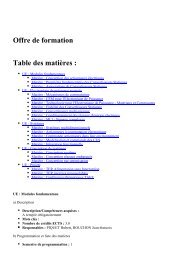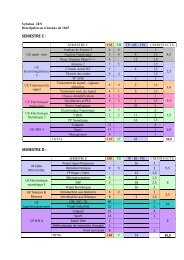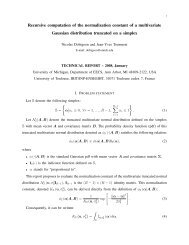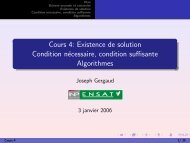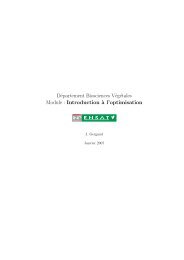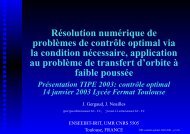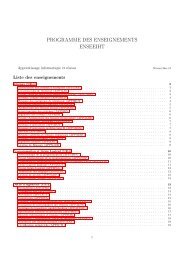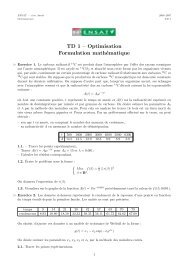cours et TD - Enseeiht
cours et TD - Enseeiht
cours et TD - Enseeiht
- No tags were found...
You also want an ePaper? Increase the reach of your titles
YUMPU automatically turns print PDFs into web optimized ePapers that Google loves.
72 CHAPITRE 4.THÉORIE DE L’ÉCHANTILLONNAGE4.3 Distribution d’échantillonnage de <strong>TD</strong>ans les théorèmes précédents on a vu que si la variable aléatoire X suit une loi normale <strong>et</strong> si l’échantillon estBernoullien alors la variable aléatoireȲ − µσ √ nsuit une loi normale centrée réduite. L’approximation étant encore valable si X adment une espérance mathématiqueµ <strong>et</strong> une variance σ 2 finies <strong>et</strong> si n est grand (n ≥ 30 en pratique). Mais dans la réalité nous ne connaissons pas σ<strong>et</strong> il est donc logique de ce demander ce qui ce passe si on renplace σ par√nn−1 S2 (Y ). C’est ce que nous allonsétudier maintenant.Théorème 4.3.1. Si (Y 1 , . . . , Y n ) est un échantillon Bernoullien <strong>et</strong> si X suit une loi normale de paramètre (µ, σ),alors la statistique :T = M − µ √S2suit une loi de Student à (n − 1) degrés de liberté.DémonstrationOn a :avecT =n − 1qU ,ZνU = M − µσ√ nde loi N (0, 1),Z = nS2σ 2 de loi χ 2 ν=n−1degrés de liberté,<strong>et</strong> U <strong>et</strong> Z indépendantes. Par suite T suit une loi de Student à n − 1 degrés de liberté.4.4 Distribution d’échantillonnage du rapport de varianceNous allons maintenant nous intéresser à la distribution d’échantillonnage du rapport de variance.Théorème 4.4.1. On considère deux caractères X 1 <strong>et</strong> X 2 de loi normale respectivement N (µ 1 , σ1) 2 <strong>et</strong> N (µ 2 , σ2).2Soient deux échantillons Bernoullien indépendants (Y 11 , . . . , Y 1n1 ) <strong>et</strong> (Y 21 , . . . , Y 2n2 ). Si S1 2 (respectivement S2) 2 estla statistique S1(y) 2 = 1 ∑ n1n 1 i=1 (y 1i − ȳ 1 ) 2 (respectivement S2(y) 2 = 1 ∑ n2n 2 i=1 (y 2i − ȳ 2 ) 2 ) alors la statistique :F =n 1 S 2 1(n 1 − 1)σ 2 1n 2 S 2 2(n 2 − 1)σ 2 2suit une loi de Fischer-Snedecor à n 1 − 1 degrés de liberté au numérateur <strong>et</strong> à n 2 − 1 degrés de liberté audénominateur.DémonstrationD’après le théorème (4.2.1) n 1 S2 1σ12 (respectivement n 2 S2 2σ22 ) suit une loi du χ 2 à n 1 −1 (respectivement n 2 −1) degrés de liberté <strong>et</strong> les hypothèses duthéorème impliquent que ces variables aléatoires sont indépendantes. On en déduit alors immédiatement le résultat en considérant la définitiond’une loi de Fisher-Snedecor. ✷La figure 4.6 donne une illustration, via la simulation d’une loi de Fisher à ν 1 = 5 ddl au nuérateur <strong>et</strong> ν 2 = 3ddl au dénominateur.4.5 Distribution d’échantillonnage d’une fréquenceNous allons terminer c<strong>et</strong>te section en rappelant la distribution d’échantillonnage d’une proportion.Théorème 4.5.1. Soit X une variable aléatoire de Bernoulli de paramètre p <strong>et</strong> soit (Y 1 , . . . , Y n ) un n-échantillonaléatoire. Posons S(y) = ∑ ni=1 y i <strong>et</strong> M(y) = 1 n∑ ni=1 y i, alors :(i) si l’échantillon est avec remise ou si la population est infinieS suit une loi binômiale de paramètre (n, p) <strong>et</strong> :✷E(S) = npV ar(S) = npqE(Ȳ ) = pV ar(Ȳ ) = pqn



